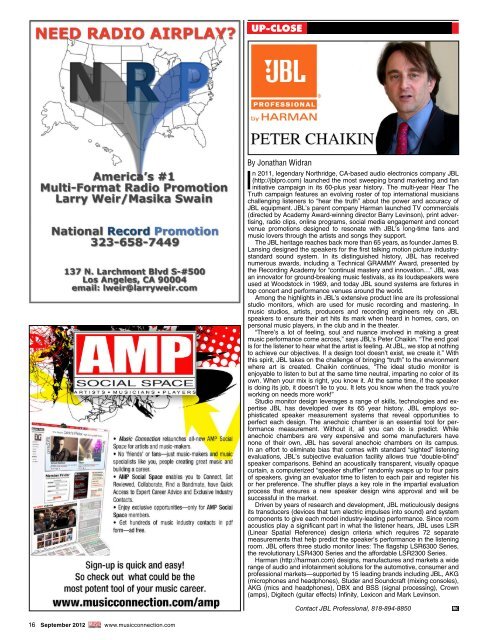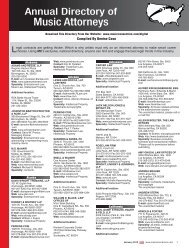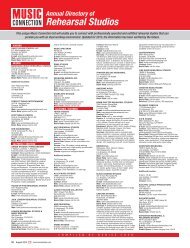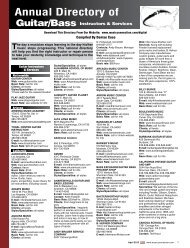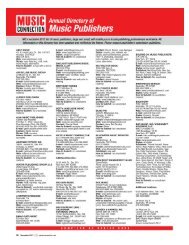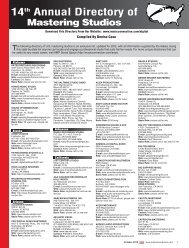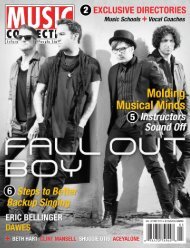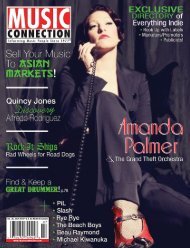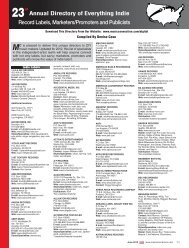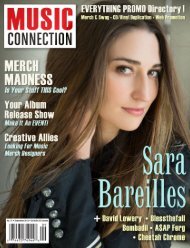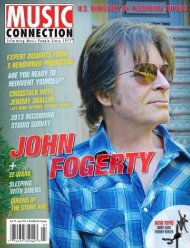TruSource Technology DL2 Integrated Digital Mixer
September 2012 - Music Connection
September 2012 - Music Connection
- No tags were found...
Create successful ePaper yourself
Turn your PDF publications into a flip-book with our unique Google optimized e-Paper software.
UP-CLOSE<br />
By Jonathan Widran<br />
In 2011, legendary Northridge, CA-based audio electronics company JBL<br />
(http://jblpro.com) launched the most sweeping brand marketing and fan<br />
initiative campaign in its 60-plus year history. The multi-year Hear The<br />
Truth campaign features an evolving roster of top international musicians<br />
challenging listeners to “hear the truth” about the power and accuracy of<br />
JBL equipment. JBL’s parent company Harman launched TV commercials<br />
(directed by Academy Award-winning director Barry Levinson), print advertising,<br />
radio clips, online programs, social media engagement and concert<br />
venue promotions designed to resonate with JBL’s long-time fans and<br />
music lovers through the artists and songs they support.<br />
The JBL heritage reaches back more than 65 years, as founder James B.<br />
Lansing designed the speakers for the first talking motion picture industrystandard<br />
sound system. In its distinguished history, JBL has received<br />
numerous awards, including a Technical GRAMMY Award, presented by<br />
the Recording Academy for “continual mastery and innovation…” JBL was<br />
an innovator for ground-breaking music festivals, as its loudspeakers were<br />
used at Woodstock in 1969, and today JBL sound systems are fixtures in<br />
top concert and performance venues around the world.<br />
Among the highlights in JBL’s extensive product line are its professional<br />
studio monitors, which are used for music recording and mastering. In<br />
music studios, artists, producers and recording engineers rely on JBL<br />
speakers to ensure their art hits its mark when heard in homes, cars, on<br />
personal music players, in the club and in the theater.<br />
“There’s a lot of feeling, soul and nuance involved in making a great<br />
music performance come across,” says JBL's Peter Chaikin. “The end goal<br />
is for the listener to hear what the artist is feeling. At JBL, we stop at nothing<br />
to achieve our objectives. If a design tool doesn’t exist, we create it.” With<br />
this spirit, JBL takes on the challenge of bringing “truth” to the environment<br />
where art is created. Chaikin continues, “The ideal studio monitor is<br />
enjoyable to listen to but at the same time neutral, imparting no color of its<br />
own. When your mix is right, you know it. At the same time, if the speaker<br />
is doing its job, it doesn’t lie to you. It lets you know when the track you’re<br />
working on needs more work!”<br />
Studio monitor design leverages a range of skills, technologies and expertise<br />
JBL has developed over its 65 year history. JBL employs sophisticated<br />
speaker measurement systems that reveal opportunities to<br />
perfect each design. The anechoic chamber is an essential tool for performance<br />
measurement. Without it, all you can do is predict. While<br />
anechoic chambers are very expensive and some manufacturers have<br />
none of their own, JBL has several anechoic chambers on its campus.<br />
In an effort to eliminate bias that comes with standard “sighted” listening<br />
evaluations, JBL’s subjective evaluation facility allows true “double-blind”<br />
speaker comparisons. Behind an acoustically transparent, visually opaque<br />
curtain, a computerized “speaker shuffler” randomly swaps up to four pairs<br />
of speakers, giving an evaluator time to listen to each pair and register his<br />
or her preference. The shuffler plays a key role in the impartial evaluation<br />
process that ensures a new speaker design wins approval and will be<br />
successful in the market.<br />
Driven by years of research and development, JBL meticulously designs<br />
its transducers (devices that turn electric impulses into sound) and system<br />
components to give each model industry-leading performance. Since room<br />
acoustics play a significant part in what the listener hears, JBL uses LSR<br />
(Linear Spatial Reference) design criteria which requires 72 separate<br />
measurements that help predict the speaker’s performance in the listening<br />
room. JBL offers three studio monitor lines: The flagship LSR6300 Series,<br />
the revolutionary LSR4300 Series and the affordable LSR2300 Series.<br />
Harman (http://harman.com) designs, manufactures and markets a wide<br />
range of audio and infotainment solutions for the automotive, consumer and<br />
professional markets—supported by 15 leading brands including JBL, AKG<br />
(microphones and headphones), Studer and Soundcraft (mixing consoles),<br />
AKG (mics and headphones), DBX and BSS (signal processing), Crown<br />
(amps), Digitech (guitar effects) Infinity, Lexicon and Mark Levinson.<br />
Contact JBL Professional, 818-894-8850<br />
16 September 2012 www.musicconnection.com


